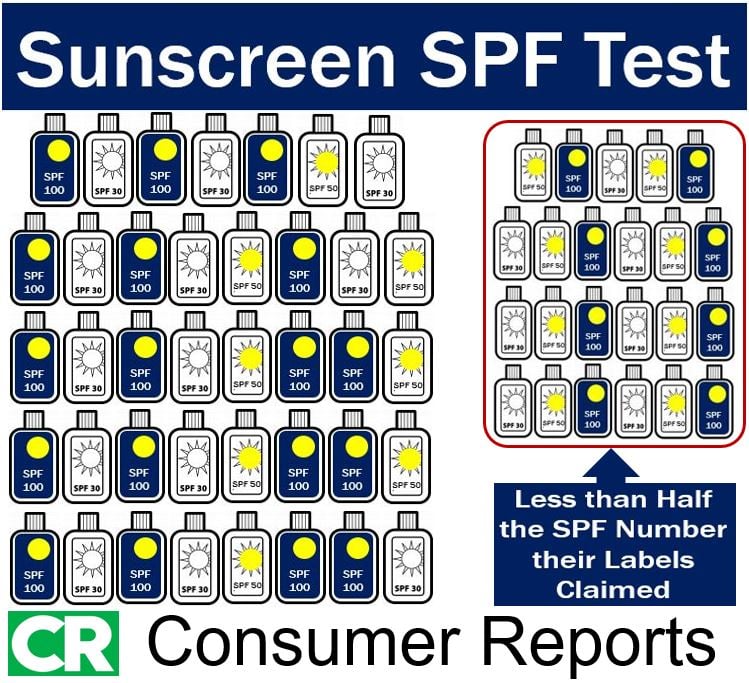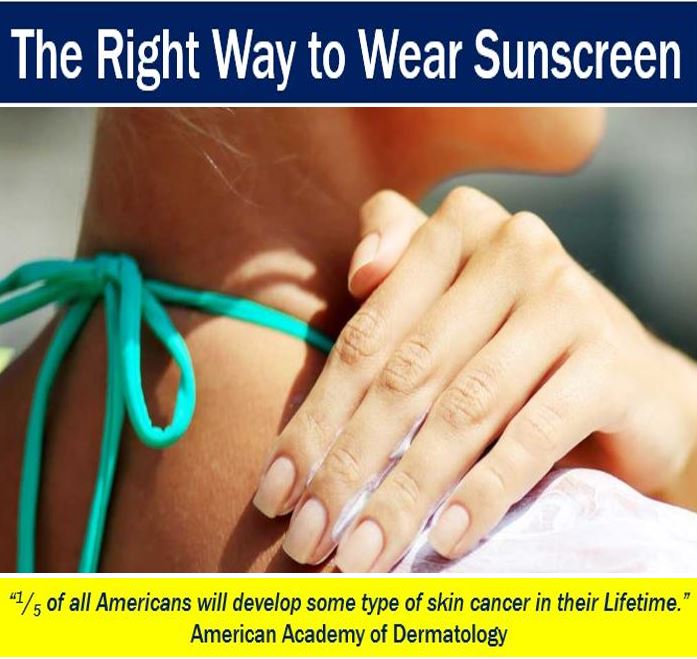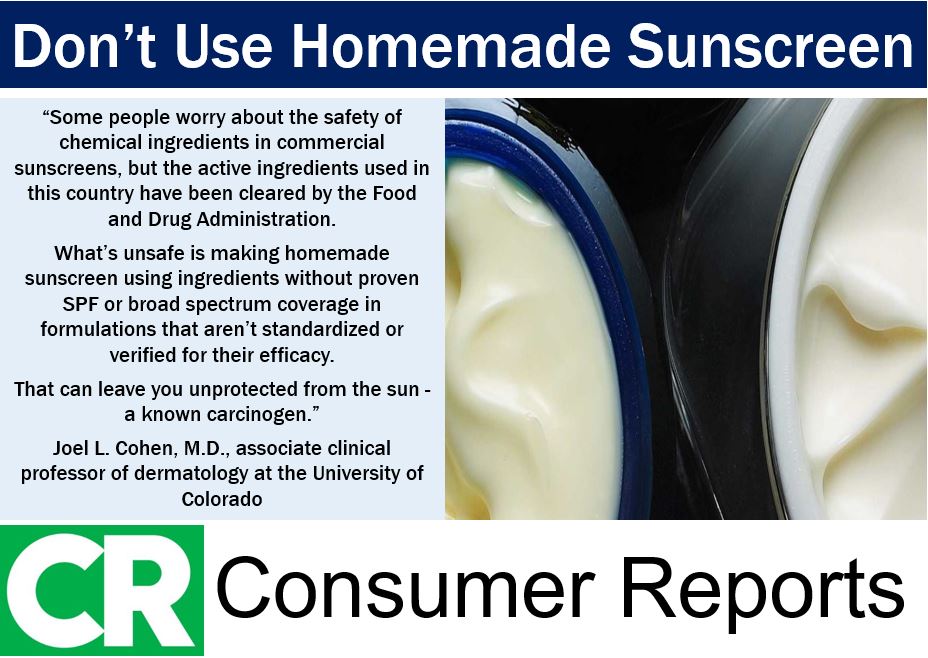Sunscreen SPFs (Sun Protection Factors) are not always what the labels claim, warns Consumer Reports, a magazine published by the Consumers Union, a United States-based non-profit organization. Researchers tested more than sixty sunscreens, lip balms, sticks, and sprays to determine how reliable and accurate their SPF numbers were.
SPF measures sunscreen protection from ultraviolet B (UVB) radiation – the kind that causes sunburn and increases our risk of developing skin cancer. The higher the SPF number, the greater protection from UVB rays the sunscreen is supposed to offer.
Consumer Reports researchers also tested the 60+ sunscreens for ultraviolet A (UVA) radiation, which tans and ages skin, and can also trigger skin cancer.
 Of 63 products tested, 23 had less than half their stated SPFs. Do not rely 100% on what the manufacturer tells you regarding its sunscreen SPF. Check with your country’s consumer protection organization for any recommended products.
Of 63 products tested, 23 had less than half their stated SPFs. Do not rely 100% on what the manufacturer tells you regarding its sunscreen SPF. Check with your country’s consumer protection organization for any recommended products.
How sunscreen SPF numbers work
SPF is a relative measure of how long a sunscreen will protect a human’s skin from UVB radiation. In most cases, the number is explained as the amount of time it takes our skin to burn when sunscreen is applied to it compared to when it is not.
For example, if a person applies – and also reapplies – the product correctly, if they would normally burn after twenty minutes (one-third of an hour) of direct sunlight exposure, an SPF 30 will protect for approximately 10 hours (thirty times one-third equals 10).
However, the wavelength distribution and intensity of UVB radiation varies according to location, how clear the sky is, and time of day.
This calculation only applies to UVB rays – not UVA radiation. That is why a broad-spectrum sunscreen is best – the type that provides protection against both UVB and UVA radiation.
SPF 30 is said to block at 97%, SPF 50 98%, and SPF 100 99%.
 Consumer Reports quoted an American Academy of Dermatology Study that found that just 33% of people who use sunscreen apply it to all of their skin (we should). Consumer reports wrote: “It takes an ounce to adequately cover your body from heat to toe when you are in a bathing suit.” (Image: adapted from consumerreports.org)
Consumer Reports quoted an American Academy of Dermatology Study that found that just 33% of people who use sunscreen apply it to all of their skin (we should). Consumer reports wrote: “It takes an ounce to adequately cover your body from heat to toe when you are in a bathing suit.” (Image: adapted from consumerreports.org)
Volunteers’ skin tested
Consumer Reports only tested sunscreens with a listed SPF of 30+ that were also water resistant for 40 to 80 minutes.
The volunteers (panelists) had sunscreen applied to six places on their backs. They then soaked in a tub of water, after which they were exposed to six different intensities of UVB light from a sun simulator for set lengths of time.
On the following day, the six spots on their backs were examined for redness.
To test for UVA radiation protection, the researchers smeared sunscreen onto plastic plates and passed UV light through, and then measured how much UVB radiation was absorbed.
Sunscreen test results
Of the sixty-two sunscreen lotions, sticks, sprays, and lip balms tested this year, twenty-three were found to have less than half the SPF number that their labels claimed. This does not mean that these 23 products offer no production – it just means they are less than half of what they claim to be.
These test results were not surprising, the researchers said. Over the last five years of sunscreen testing, they have seen a similar pattern.
More than half of all sunscreens tested by Consumer Reports researchers were found to have a real SPF number that was below what was printed on their labels.
So called ‘natural’ or ‘mineral’ sunscreens – with only zinc oxide, titanium dioxide or both as active ingredients – over the past five years have tended to perform less well than those with avobenzone and other chemical active ingredients.
 Consumer Reports warns that the thousands of homemade sunscreen recipes you can find online are significantly inferior to the products you can buy in the shops. They do not provide the protection that your skin needs. (Image: adapted from consumerreports.org)
Consumer Reports warns that the thousands of homemade sunscreen recipes you can find online are significantly inferior to the products you can buy in the shops. They do not provide the protection that your skin needs. (Image: adapted from consumerreports.org)
Not one of the mineral sunscreens made it to this year’s list of recommended products.
In its press release about its latest test, Consumer Reports wrote:
“The sensory aspects of sunscreen are important to many people. You’re less likely to use one if you don’t like its scent or feel. Our sensory testing found many that did not feel heavy or sticky on skin, and in many cases these were also high-performing products.”
“Sunscreens come in a variety of fragrances. In addition to the classic beachy scent, the ones in our tests had tropical, floral, baby powder, citrus, and woodsy/outdoorsy notes. We also found that no fragrance doesn’t always mean no odor. Many fragrance-free sunscreens had a slight amount of plastic smell (think beach ball).”
Consumer Reports recommended the following Best Cheap Sunscreens (see video at bottom of this page):
– Equate Sport Lotion SPF 50 ($5)
– Pure Skin Defense Lotion SPF 50 ($6)
– Equate Ultra Protection Lotion SPF 50 ($8)
– Trader Joe’s Spray SPF 50+ ($6)
– Equate Sport Continuous Spray SPF 30 ($9)
Video – Sunscreen recommendations
This Consumer Reports video lists five of its recommended cheap buys.
